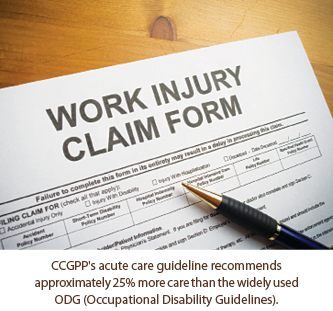:dropcap_open:I:dropcap_close:t has come to my attention that yet another small group of individuals in our profession is hard at work spreading misinformation amongst their colleagues, this time in regards to CCGPP’s formulation of acute and chronic care guidelines and treatment algorithms. Since these previously published guidelines were developed for the sole reason of successfully helping the profession and its individual doctors, I would like to explain how these guidelines and subsequent algorithms came about.
Guideline Development:
 The Council on Chiropractic Guidelines and Practice Parameters (CCGPP), was formed in 1995 at the behest of the Congress of Chiropractic State Associations (COCSA) and with assistance from the American Chiropractic Association (ACA), the Association of Chiropractic Colleges (ACC), the Council on Chiropractic Education (CCE), the Federation of Chiropractic Licensing Boards (FCLB), the Foundation for the Advancement of Chiropractic Sciences (FACS), the Foundation for Chiropractic Education and Research (FCER), the International Chiropractors Association (ICA), the National Association of Chiropractic Attorneys (NACA) and the National Institute for Chiropractic Research (NICR).
The Council on Chiropractic Guidelines and Practice Parameters (CCGPP), was formed in 1995 at the behest of the Congress of Chiropractic State Associations (COCSA) and with assistance from the American Chiropractic Association (ACA), the Association of Chiropractic Colleges (ACC), the Council on Chiropractic Education (CCE), the Federation of Chiropractic Licensing Boards (FCLB), the Foundation for the Advancement of Chiropractic Sciences (FACS), the Foundation for Chiropractic Education and Research (FCER), the International Chiropractors Association (ICA), the National Association of Chiropractic Attorneys (NACA) and the National Institute for Chiropractic Research (NICR).
The CCGPP’s mission is to provide consistent and widely adopted chiropractic practice information, to perpetually distribute and update this data, as is necessary, so that doctors, consumers and others have reliable information on which to base informed health care decisions. CCGPP was also delegated to examine all existing guidelines, parameters, protocols and best practices in the United States and other nations with a chiropractic lens. Participation and process has been as transparent as possible and a major goal is to represent a diverse cross-section of the profession on the projects that CCGPP has been involved in.
While CCGPP initially had no interest in guidelines, a request was made by the state of California (where one out of 6 DCs in the USA reside) to develop an acute care guideline, since existing guidelines, and guidelines being considered by the state’s workers’ compensation system were developed primarily by medical physicians and were overly restrictive towards care rendered by chiropractic physicians. Clearly, there was a need for a guideline developed with a chiropractic lens and honest evaluation of the literature versus biased medical-driven interpretations of the literature. As a result, Delphi panels were formed to develop initial acute care and later chronic care guidelines which included widespread representation from all corners of our profession. It was an inclusive and very transparent process. In the end, our profession did something very historic. We reached over 80% consensus on both guidelines and greatly expanded the recommendations compared to virtually all other guidelines currently in use by most payors in the United States (which were developed with little, if any, chiropractic input and were very medically-biased).
CCGPP’s acute care guideline recommends approximately 25% more care than the widely used ODG (Occupational Disability Guidelines). ODG actually incorporated CCGPP’s acute and chronic care recommendations in the “current research” section of their guideline. CCGPP’s chronic care guideline recommends up to 1-4 visits per month to help “control” those patients suffering chronic pain. Again, this recommendation is far better than any other guideline of which we are aware. CCGPP’s acute and chronic care guidelines provide clear direction on how to document complicating factors, response to care, etc. to help explain why care may extend beyond the initial recommendations proposed. CCGPP spends a great deal of time reminding payors, consultants, and other interested parties on the “proper” use of guidelines and reminds everyone that guidelines are just that, “guidelines”, not cookbooks for care.
The Delphi Process:
The purpose of the Delphi process is to elicit information and judgments from participants to facilitate problem-solving, planning, and decision-making. It does so without physically assembling the participants. Instead, information is exchanged via mail, FAX, or email. It is structured to capitalize on the merits of group problem-solving and minimize the liabilities of group problem-solving. The Delphi technique requires a facilitator/director to organize and conduct the process, manage the information, and ensure that procedures are followed correctly. Dr. Cheryl Hawk served in this position.
:dropcap_open:In analyzing the responses, the median response was calculated for each item.:quoteleft_close:
Representation of all stakeholders is essential, and the group should represent both topic-specific academic/research expertise and a cross-section of the profession. Multidisciplinary input is also sought from our affected stakeholders. CCGPP sought nominations from COCSA and also sent a request to an extensive list of chiropractic organizations, including ACA, ICA and WCA, as well as their business partners and associates, to ensure adequate representation.
In making nominations, the organizations were asked to take the following factors into account in order to form a group that provides clinical expertise and represents the profession accurately and with diversity: geographic location (state/region), urban/suburban/rural location, chiropractic college of graduation, high volume/low volume practice, technique, manual only/manual plus modalities, scope of practice (broad/focused), experience in reading and evaluating the literature (demonstrated by advanced degree, post-grad work, publications, teaching), at least 5 years of experience in full-time clinical practice, currently licensed and practicing in the USA.
Panelists were first provided with background documents, including summaries of current guidelines in common use and recent relevant articles from the scientific literature. Three Delphi rounds were conducted, with the seed document revised as per the panelists’ responses between each round.
In analyzing the responses, the median response was calculated for each item. Medians, unlike means, take extreme responses into consideration and so will better ensure that each participant’s response will have an impact on the total. Agreement was present only with 80%+ consensus.
Algorithm Development:
 Despite how well-written the acute and chronic care guidelines are, we realize that a great many doctors simply have not taken the time to read them and, consequently, we are currently embarked on an initiative to simplify the contents for the average field doctor via the creation of visual “algorithms”. Unfortunately, an individual inappropriately released the DRAFTS of these documents, without any accurate explanation as to the clear benefits, intent, or use of the algorithms and has inappropriately been discussing and voicing concerns regarding these. Please be aware that the algorithms being developed contain NO NEW information, but are merely visual treatment algorithms based entirely on papers that were already published. Our goal is simply to help doctors in their cognitive flow regarding clinical decision making and treatment of patients in their offices for acute conditions and for chronic conditions. We are NOT setting standards for the profession. Anyone who read the acute and chronic care guidelines already realizes the difference between benchmarks for care, proper use of guidelines and standards.
Despite how well-written the acute and chronic care guidelines are, we realize that a great many doctors simply have not taken the time to read them and, consequently, we are currently embarked on an initiative to simplify the contents for the average field doctor via the creation of visual “algorithms”. Unfortunately, an individual inappropriately released the DRAFTS of these documents, without any accurate explanation as to the clear benefits, intent, or use of the algorithms and has inappropriately been discussing and voicing concerns regarding these. Please be aware that the algorithms being developed contain NO NEW information, but are merely visual treatment algorithms based entirely on papers that were already published. Our goal is simply to help doctors in their cognitive flow regarding clinical decision making and treatment of patients in their offices for acute conditions and for chronic conditions. We are NOT setting standards for the profession. Anyone who read the acute and chronic care guidelines already realizes the difference between benchmarks for care, proper use of guidelines and standards.
The individuals who are spreading misinformation are claiming that these algorithms were never reviewed by the profession, even though one of their own board members was on both Delphi Panels and thus part of the process of developing the guidelines. They confusingly also claim that the algorithms are restrictive, should not contain numbers, and should not have been disseminated, despite the fact that they were already published in a peer-reviewed journal after an extensive and transparent Delphi process. Doctors across the profession recommend treatment plans to their patients that are based on numbers of visits per week, followed by re-evaluations. Many insurance companies and managed care companies use their own visit frequency and duration guidelines that are often very restrictive, because they do not use quality literature or use very biased medical interpretations of the literature. Often guidelines are based on uncomplicated case, versus the reality of what we deal with in our offices every day.
The bottom line is that, either our profession develops guidelines for ourselves or others outside the profession, who have no interest in the care of patients, will develop or have already developed them for us. The recommendations in our documents merely provide benchmarks for care in order measure the response to treatment, but are not prescriptive and do NOT represent limits for care. They take into consideration complicated and chronic cases and even cases that will never fully resolve. It is important to understand that these algorithms are for spine-related pain conditions only. They are not designed for other clinical objectives such as subluxation-focused care, postural care, wellness care, etc. and the introductory paper makes this clear.
 Please keep in mind that the original published guidelines and the subsequent pictorial description of the guidelines in algorithm form are based on the current level of scientific evidence. That is not to say that other forms of care may not work. CCGPP is only reporting on what we know, based on the highest level of scientific evidence to date. As more clinical research becomes available, CCGPP will update the guidelines and algorithms to support the most current knowledge base.
Please keep in mind that the original published guidelines and the subsequent pictorial description of the guidelines in algorithm form are based on the current level of scientific evidence. That is not to say that other forms of care may not work. CCGPP is only reporting on what we know, based on the highest level of scientific evidence to date. As more clinical research becomes available, CCGPP will update the guidelines and algorithms to support the most current knowledge base.
CCGPP is anxious to get these algorithms out to the profession and into the hands of as many organizations, schools, student doctors and field practitioners as possible. Before we do that, however, we intend to subject the algorithms to the same rigorous Delphi process and then publish the outcome. Once that is done, these guidelines will no longer be our property.
There has been some concern that CCGPP’s primary objective is to make money. CCGPP does not personally own the copyright of our published products. CCGPP funds the work through donations, sponsors and membership dues. CCGPP only recently agreed to give its board chairman a small stipend to compensate for the extraordinary amount of time it takes to fill this position. No one else on CCGPP’s board receives any compensation; in fact our board members pay dues to the organization, so these dedicated and hard-working doctors are paying to do all this work for free. Ironically, the members of the organization that is leveling this criticism are paid to sit on their board.
:quoteright_open:CCGPP funds the work through donations, sponsors and membership dues.:quoteright_close:
So, why is there a need for guidelines to be produced by our own profession? As previously stated, if we do not produce these, someone else will. In fact, a number of insurance companies have already done this. Would you prefer to be held to the recommendations / guidelines of ASHN, Optum Health, ACOEM, Milliman and Roberts or ODG? At least with CCGPP’s evidence-based guidelines, which do stand up to scientific scrutiny, doctors of chiropractic have a fighting chance to defend their care, to fight back against unjust denials, and to fight back against bad consultants.
:dropcap_open:Please ensure the message that is being delivered is accurate and if it is not, please do your part to correct the perpetrator of any misinformation.:quoteleft_close:
CCGPP is responsive to any requests we receive for support and information through our Rapid Response Team and we have a group of the profession’s top scientific minds at our disposal to help research and answer many of these questions. The fact is, CCGPP has always been and will continue to be here to help you as a doctor or to help your association or other chiropractic organizations. CCGPP is not here to restrict you, to express any strong biased statements or sentiments or to team up with the insurers against doctors. CCGPP exists for the following reasons: to help every chiropractic doctor make evidence-based clinical decisions and to be able to confidently and successfully defend his or her care, as well as ultimately improving patient outcomes.
Conclusions:
1) Please go back and read the papers CCGPP published in JMPT. These should be close at hand on every doctor’s shelf, 2) Please go to our website at www.CCGPP.org (this is undergoing a dramatic restructure that will make it much more useful and user-friendly) and get copies of the Acute and Chronic care guidelines. Read these and become familiar with the guidelines, 3) Keep your eyes open for the Treatment Algorithm tools and get these as soon as they become available, 4) Now you know the facts. If one of the individuals spreading the misinformation about CCGPP, the guidelines and the algorithms approaches you, you are now armed with the truth. It is every DC’s responsibility and every chiropractic organization’s responsibility to be accurate about the intent and actions of CCGPP for the benefit of the profession. Please ensure the message that is being delivered is accurate and if it is not, please do your part to correct the perpetrator of any misinformation.
CCGPP will continue to work hard to help the chiropractic profession.
Thomas J. Augat, DC, MS, CCSP, FASA is the chairman of CCGPP. He is past president of the Northeast Chiropractic Council and the Maine Chiropractic Association. He graduated with academic and research honors from Palmer College – Davenport. Dr. Augat has practiced 24 years in Brunswick, Maine. Contact CCGPP at [email protected].


 How Real is the Chiropractic Pediatric Malpractice Risk? The exceptional safety record of chiropractic across all categories of patients extends, thankfully, to the child patient population as well. While chiropractic pediatric malpractice claims are rare, especially by comparison to medicine, the reality of exposure should not be minimized. This is especially true given the highly emotional nature of issues related to children and the damaging nature of any implication that a health care professional may be at fault.
How Real is the Chiropractic Pediatric Malpractice Risk? The exceptional safety record of chiropractic across all categories of patients extends, thankfully, to the child patient population as well. While chiropractic pediatric malpractice claims are rare, especially by comparison to medicine, the reality of exposure should not be minimized. This is especially true given the highly emotional nature of issues related to children and the damaging nature of any implication that a health care professional may be at fault.


 :dropcap_open:I:dropcap_close:f you are shopping for an Electronic Health Record system, chances are you will follow this path: You will choose to call 4 or 5 companies you have heard the most from other fellow chiropractors, or you have seen in chiropractic seminars or magazines. At this point, they are all the same for you. They all claim they have the best service, the best system and the lowest cost. So, you will ask for a demo, online or live at the seminar. As a bonus, you just find out the system is free and in the process to become certified for the Stimulus incentive package. So, you automatically become eligible to receive 44,000 dollars from the government. Wow, what a deal! That was easy…. You are almost ready to make your final decision. Let’s go fast because the government may have given all his Stimulus dollars to the fastest decision maker and maybe there will not be any dollars left for you. Hurry up; let’s buy some computers and go for it! Decision made…done deal!
:dropcap_open:I:dropcap_close:f you are shopping for an Electronic Health Record system, chances are you will follow this path: You will choose to call 4 or 5 companies you have heard the most from other fellow chiropractors, or you have seen in chiropractic seminars or magazines. At this point, they are all the same for you. They all claim they have the best service, the best system and the lowest cost. So, you will ask for a demo, online or live at the seminar. As a bonus, you just find out the system is free and in the process to become certified for the Stimulus incentive package. So, you automatically become eligible to receive 44,000 dollars from the government. Wow, what a deal! That was easy…. You are almost ready to make your final decision. Let’s go fast because the government may have given all his Stimulus dollars to the fastest decision maker and maybe there will not be any dollars left for you. Hurry up; let’s buy some computers and go for it! Decision made…done deal!
 :dropcap_open:A:dropcap_close:s Doctors of Chiropractic, as well as business professionals managing a practice, we are bombarded with solicitations to better our practice, improve our equipment, update our technology, and incorporate the “next best thing.” The economic realities of today, however, demand that we not add more and more “stuff,” but rather that we find a way to do more with less. The road to efficiency is paved with streamlined operations, discarding what’s unnecessary, automating processes, and simplifying what remains.
:dropcap_open:A:dropcap_close:s Doctors of Chiropractic, as well as business professionals managing a practice, we are bombarded with solicitations to better our practice, improve our equipment, update our technology, and incorporate the “next best thing.” The economic realities of today, however, demand that we not add more and more “stuff,” but rather that we find a way to do more with less. The road to efficiency is paved with streamlined operations, discarding what’s unnecessary, automating processes, and simplifying what remains.
 :dropcap_open:T:dropcap_close:he following are traps that many doctors, as business owners, fall into and, if you can avoid them, you could make a lasting change in your business.
:dropcap_open:T:dropcap_close:he following are traps that many doctors, as business owners, fall into and, if you can avoid them, you could make a lasting change in your business.
 :dropcap_open:A:dropcap_close:lmost every new patient encounter will begin with the phone call that potential new patient will make to schedule their initial visit. Setting the financial tone of the relationship with that potential patient as early as the initial phone call lays the groundwork for a healthy partnership in the years to come. In the same manner that we might not go to the mall and purchase a new outfit without first taking a peek at the price tag, most new patients will want to know the costs associated with their care before they begin. Communicating this information effectively without scaring the patient away is a finely tuned dance that requires confidence, knowledge, and effortless ease.
:dropcap_open:A:dropcap_close:lmost every new patient encounter will begin with the phone call that potential new patient will make to schedule their initial visit. Setting the financial tone of the relationship with that potential patient as early as the initial phone call lays the groundwork for a healthy partnership in the years to come. In the same manner that we might not go to the mall and purchase a new outfit without first taking a peek at the price tag, most new patients will want to know the costs associated with their care before they begin. Communicating this information effectively without scaring the patient away is a finely tuned dance that requires confidence, knowledge, and effortless ease.
 :dropcap_open:O:dropcap_close:ur Federal government keeps coming up with ideas to give all of us more money!!! At least that is what they claim. If you use certified Electronic Health Record (EHR) computer software and demonstrate meaningful use of that EHR, then you may qualify for up to $44,000.00 in bonus payments from Medicare. The bonus is NOT based on the cost of the EHR program. The amount of the bonus is determined by the amount of money Medicare pays you. Medicare sets the bonus at about 75% of what they normally pay you. So if your annual Medicare payment is only $1,000 you will get a bonus check for $750; if the payment is $25,000, your bonus check will be $18,000. Should you qualify for the maximum bonus each year for 3 years in a row, your bonus checks will total $44,000.
:dropcap_open:O:dropcap_close:ur Federal government keeps coming up with ideas to give all of us more money!!! At least that is what they claim. If you use certified Electronic Health Record (EHR) computer software and demonstrate meaningful use of that EHR, then you may qualify for up to $44,000.00 in bonus payments from Medicare. The bonus is NOT based on the cost of the EHR program. The amount of the bonus is determined by the amount of money Medicare pays you. Medicare sets the bonus at about 75% of what they normally pay you. So if your annual Medicare payment is only $1,000 you will get a bonus check for $750; if the payment is $25,000, your bonus check will be $18,000. Should you qualify for the maximum bonus each year for 3 years in a row, your bonus checks will total $44,000.